|
Nissan Cima / Infiniti Q45
Debut: 2001
Maker: Nissan
Predecessor: Cima / Q45 (1996)
|
|
 The
best Q45 in 2 generations is still the Mk1 - most beautiful, most
elegant,
advanced technology used (4-wheel steering and even semi-active
suspensions).
There’s no doubt that it is perceived classier than the 2nd generation,
otherwise Nissan won’t keep the Mk1 in its top of the range in the name
of "President" until today. We don’t know why Nissan chose a wrong
strategy
to downgrade the second generation, merged it with the cheaper and
smaller
Cima, detuned its V8 engine to 4.1-litre and 266 hp, gifted it a
conservative
appearance and took away its sporty-biased suspensions. Perhaps that
was
a reaction to economic recession, but was that over-reacted ? The
best Q45 in 2 generations is still the Mk1 - most beautiful, most
elegant,
advanced technology used (4-wheel steering and even semi-active
suspensions).
There’s no doubt that it is perceived classier than the 2nd generation,
otherwise Nissan won’t keep the Mk1 in its top of the range in the name
of "President" until today. We don’t know why Nissan chose a wrong
strategy
to downgrade the second generation, merged it with the cheaper and
smaller
Cima, detuned its V8 engine to 4.1-litre and 266 hp, gifted it a
conservative
appearance and took away its sporty-biased suspensions. Perhaps that
was
a reaction to economic recession, but was that over-reacted ?
Comparatively,
the third
generation was born of positive thinking, though saying Renault has any
significant influence to its development is untrue. The new Q45 (and
Japan’s
Cima) dares to be different. From the radical - if a bit inartistic and
insensible - shape you’ll see Nissan’s designers have restored
confidence,
perhaps over-confident. The organic face with big eyes and man-eating
mouth
looks better in real thing than photo, as I can testify, but it fails
to
deliver any messages of prestige or elegance. Park beside an Audi A8 or
Jaguar XJ8, it suddenly become a pump-up Maxima (Cefiro). Even a
Volkswagen
Passat feels more elegant than the radical Nissan, blame to the organic
design and scarce of chromed details.
As
before, the
car is 5 meters
long, rear-drive and rides on front MacPherson struts and rear
multi-link
suspensions. The body is wider, taller but no longer. Cd. is a so-so
0.30.
40% increase of torsional rigidity provides the necessary crash
protection
and tauter handling that today’s customers require. More usage of
aluminium
castings help reducing the unsprung weight of suspensions by a little
bit,
about 5-10%.
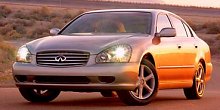 Forget
it. What improves most is the V8 power plant, a development from the
famous
VQ-series V6 engine. Now it has restored the 4.5-litre displacement, in
addition to continuous variable valve timing, 2-stage variable length
intake
manifold and 2-stage variable exhaust, it would have pumped out 330hp.
However, the final figure has been increased to 340hp because the
Japanese
engineers pioneered the world’s first valves made of titanium alloy,
which
is 40% lighter. Why not titanium connecting rods like many supercars?
that
would have been more effective to power enhancement but Nissan’s
intention
was actually to cut valve-gear noise. Forget
it. What improves most is the V8 power plant, a development from the
famous
VQ-series V6 engine. Now it has restored the 4.5-litre displacement, in
addition to continuous variable valve timing, 2-stage variable length
intake
manifold and 2-stage variable exhaust, it would have pumped out 330hp.
However, the final figure has been increased to 340hp because the
Japanese
engineers pioneered the world’s first valves made of titanium alloy,
which
is 40% lighter. Why not titanium connecting rods like many supercars?
that
would have been more effective to power enhancement but Nissan’s
intention
was actually to cut valve-gear noise.
Japanese
version
of the engine,
called VK45DD, even employs direct-injection (therefore the second "D"
in its name) to improve fuel economy, which is 22% more efficient than
the old 4.1-litre engine. As usual, direct injection allow a higher
compression
ratio - 11.0:1 instead of the overseas version’s 10.5:1, though power
figure
will never reflect that because it is bounded by the 280hp voluntary
limit
- officially. Who believe that ?
Still, 340 hp
and
333 lbft
of torque is already class leading (don’t compare it with
12-cylinders).
You need a sporting Audi S8 to beat it. The problem is no one ever
matches
the wild performance claim of doing 0-60 in 5.9 seconds. Most found 6.5
sec more reasonable while the car never feel as powerful as the number
suggest. The 5-speed Tiptronic-style automatic seems not the reason. It
is the torque curve that prevent it from feeling fire-breathing. At
1,600
rpm, there is "just" 78% of the maximum torque available. The peak
arrives
at 4,000rpm, some 500 above Lexus LS430.
The chassis is
another let
down. While it does not ride as supple as the Lexus arch-rival or
Mercedes
S-class, it never feel as spirited to handle as all German rivals. No
matter
how the sporting look and sporting engine suggest, suspensions are
still
bias towards comfort - maybe a bit stiffer than Lexus but body control
is no better. Steering is over-assisted and lack feel. It is easy to
drive
fast, by then engine noise and wind noise are still Lexus-like, but it
does not inspire the driver.
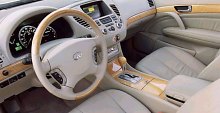 Inside,
the Q45 looks sophisticated. Light color scheme differs it from others
while the center console with computer screen looks playful. Like
HAL2000,
the computer is too clever and hard to be controlled unless you own a
university
degree. Styling-wise, I am not a fan of the light color wood and
Mitsubishi-style
center console, they just do not look as classy as rivals. Moreover,
the
plastic material could be better. Leg and shoulder room is abundance
while
rear headroom is limited by the sporting roofline. Although most people
won't find touching the roof, the cramped feeling above your head is
just
at odds to this kind of top luxury saloon. Equipment is perhaps the
only
area I have no complaint - the massager seat is still there, so is the
integrated control located at rear arm rest. The front seat back can be
folded down to serve as leg rest for the rear passenger, moreover, it
has
leg massager incorporated. To exaggerate the sense of luxury, Nissan
even
gifted it electric doors and electric boot lid. Now you need not to
close
the door and boot lid with strong hand. Just push it lightly towards
the
shut line and the electric motor will do the rest of the job and lock
it.
Useful? I’m not sure. What I’m sure is that this is a luxurious car
designed
for the back-seat boss. Inside,
the Q45 looks sophisticated. Light color scheme differs it from others
while the center console with computer screen looks playful. Like
HAL2000,
the computer is too clever and hard to be controlled unless you own a
university
degree. Styling-wise, I am not a fan of the light color wood and
Mitsubishi-style
center console, they just do not look as classy as rivals. Moreover,
the
plastic material could be better. Leg and shoulder room is abundance
while
rear headroom is limited by the sporting roofline. Although most people
won't find touching the roof, the cramped feeling above your head is
just
at odds to this kind of top luxury saloon. Equipment is perhaps the
only
area I have no complaint - the massager seat is still there, so is the
integrated control located at rear arm rest. The front seat back can be
folded down to serve as leg rest for the rear passenger, moreover, it
has
leg massager incorporated. To exaggerate the sense of luxury, Nissan
even
gifted it electric doors and electric boot lid. Now you need not to
close
the door and boot lid with strong hand. Just push it lightly towards
the
shut line and the electric motor will do the rest of the job and lock
it.
Useful? I’m not sure. What I’m sure is that this is a luxurious car
designed
for the back-seat boss.
So
what is it?
It’s not sporting,
nor classy, nor the most comfortable. It’s an infiniti without
identity.
The best of the 3 generations Q45 is still the Mk1. |
| The
above report was last updated on 21 July
2001. All Rights Reserved. |
Cima update and President
|
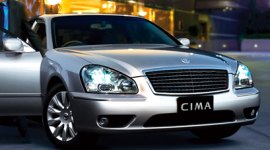 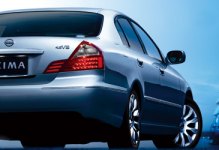 2008 Cima facelift 2008 Cima facelift
As Nissan's large car failed to catch the hearts of overseas buyers,
Infiniti Q45 came to the end in 2006. However, its domestic version
Cima continued to soldier in Japan. Changes to the Cima had been minor
- in 2003 the direct injection V8 was replaced by non-direct-injection
VK45DE; in 2005 the V6 turbo was dropped as it no longer complied with
new emission regulations; in 2008 the car was facelifted with a more
prominent front grille and a pair of Skyline / Fuga-style taillights.
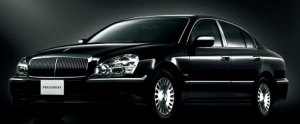 President President
Sold alongside the Cima in the domestic market is President. As before,
President is the more luxurious version of Cima aimed at the richest
Japanese businessmen, government leaders and royal family - something
like Toyota Century. Its low volume means it can hardly afford
exclusive mechanicals. Differences from Cima are limited to minor
cosmetic changes and a more luxurious interior. Most cars are ordered
in 4-seater form to better cater the rear passengers. Comfy rear chairs
offer electric recline and massager function.
|
| The
above report was last updated on 16 Aug
2009. All Rights Reserved. |
|
|
|
General remarks
|
Cima V6
|
Infiniti Q45
|
Cima (2008)
|
Layout
|
Front-engined, RWD
|
Front-engined, RWD
|
Front-engined, RWD
|
Chassis
|
Steel monocoque
|
Steel monocoque |
Steel monocoque
|
Body
|
Mainly steel
|
Mainly steel |
Mainly steel
|
| Length / width / height |
4995 / 1845
/ 1490 mm |
5070 / 1845
/ 1490 mm
|
5120 / 1845 / 1490 mm
|
| Wheelbase |
2870 mm |
2870 mm
|
2870 mm
|
Engine
|
V6, 60-degree
|
V8, 90-degree
|
V8, 90-degree
|
Capacity
|
2987 cc
|
4494 cc |
4494 cc
|
Valve gears
|
DOHC 24 valves
|
DOHC 32 valves, VVT |
DOHC 32 valves, VVT
|
Induction
|
Turbo
|
VIM
|
VIM
|
Other engine features
|
-
|
-
|
-
|
Max power
|
280 hp |
340 hp |
280 hp
|
Max torque
|
285 lbft |
333 lbft |
333 lbft
|
Transmission
|
5-speed automatic
|
5-speed automatic
|
5-speed automatic
|
Suspension layout
|
F: strut
R: multi-link
|
F: strut
R: multi-link |
F: strut
R: multi-link
|
Suspension features
|
-
|
- |
Adaptive damping
|
Tyres front/rear
|
225/55VR17
|
245/45ZR18
|
225/55VR17
|
Kerb weight
|
1700 kg (est)
|
1785 kg
|
1830 kg
|
Top speed
|
-
|
155 mph (limited)
|
-
|
0-60 mph (sec)
|
-
|
6.5*
|
-
|
0-100 mph (sec)
|
-
|
16.6*
|
-
|
| Performance
tested by: |
*R&T |
|
|